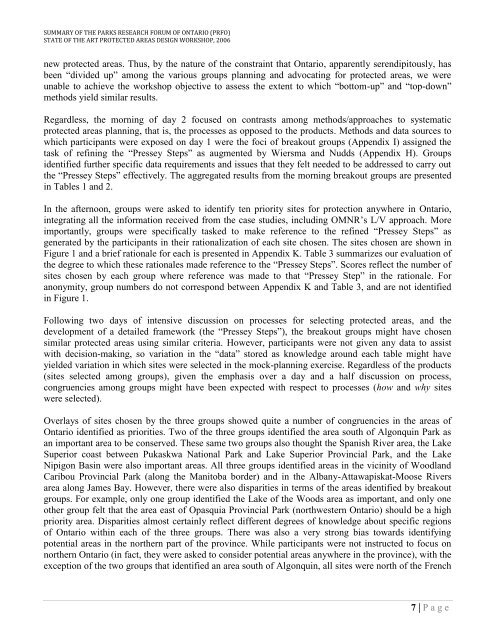Top-Down vs. Bottom Up: Working Towards Consensus ... - CASIOPA
Top-Down vs. Bottom Up: Working Towards Consensus ... - CASIOPA
Top-Down vs. Bottom Up: Working Towards Consensus ... - CASIOPA
- No tags were found...
Create successful ePaper yourself
Turn your PDF publications into a flip-book with our unique Google optimized e-Paper software.
SUMMARY OF THE PARKS RESEARCH FORUM OF ONTARIO (PRFO)STATE OF THE ART PROTECTED AREAS DESIGN WORKSHOP, 2006new protected areas. Thus, by the nature of the constraint that Ontario, apparently serendipitously, hasbeen “divided up” among the various groups planning and advocating for protected areas, we wereunable to achieve the workshop objective to assess the extent to which “bottom-up” and “top-down”methods yield similar results.Regardless, the morning of day 2 focused on contrasts among methods/approaches to systematicprotected areas planning, that is, the processes as opposed to the products. Methods and data sources towhich participants were exposed on day 1 were the foci of breakout groups (Appendix I) assigned thetask of refining the “Pressey Steps” as augmented by Wiersma and Nudds (Appendix H). Groupsidentified further specific data requirements and issues that they felt needed to be addressed to carry outthe “Pressey Steps” effectively. The aggregated results from the morning breakout groups are presentedin Tables 1 and 2.In the afternoon, groups were asked to identify ten priority sites for protection anywhere in Ontario,integrating all the information received from the case studies, including OMNR‟s L/V approach. Moreimportantly, groups were specifically tasked to make reference to the refined “Pressey Steps” asgenerated by the participants in their rationalization of each site chosen. The sites chosen are shown inFigure 1 and a brief rationale for each is presented in Appendix K. Table 3 summarizes our evaluation ofthe degree to which these rationales made reference to the “Pressey Steps”. Scores reflect the number ofsites chosen by each group where reference was made to that “Pressey Step” in the rationale. Foranonymity, group numbers do not correspond between Appendix K and Table 3, and are not identifiedin Figure 1.Following two days of intensive discussion on processes for selecting protected areas, and thedevelopment of a detailed framework (the “Pressey Steps”), the breakout groups might have chosensimilar protected areas using similar criteria. However, participants were not given any data to assistwith decision-making, so variation in the “data” stored as knowledge around each table might haveyielded variation in which sites were selected in the mock-planning exercise. Regardless of the products(sites selected among groups), given the emphasis over a day and a half discussion on process,congruencies among groups might have been expected with respect to processes (how and why siteswere selected).Overlays of sites chosen by the three groups showed quite a number of congruencies in the areas ofOntario identified as priorities. Two of the three groups identified the area south of Algonquin Park asan important area to be conserved. These same two groups also thought the Spanish River area, the LakeSuperior coast between Pukaskwa National Park and Lake Superior Provincial Park, and the LakeNipigon Basin were also important areas. All three groups identified areas in the vicinity of WoodlandCaribou Provincial Park (along the Manitoba border) and in the Albany-Attawapiskat-Moose Riversarea along James Bay. However, there were also disparities in terms of the areas identified by breakoutgroups. For example, only one group identified the Lake of the Woods area as important, and only oneother group felt that the area east of Opasquia Provincial Park (northwestern Ontario) should be a highpriority area. Disparities almost certainly reflect different degrees of knowledge about specific regionsof Ontario within each of the three groups. There was also a very strong bias towards identifyingpotential areas in the northern part of the province. While participants were not instructed to focus onnorthern Ontario (in fact, they were asked to consider potential areas anywhere in the province), with theexception of the two groups that identified an area south of Algonquin, all sites were north of the French7 | P a g e


